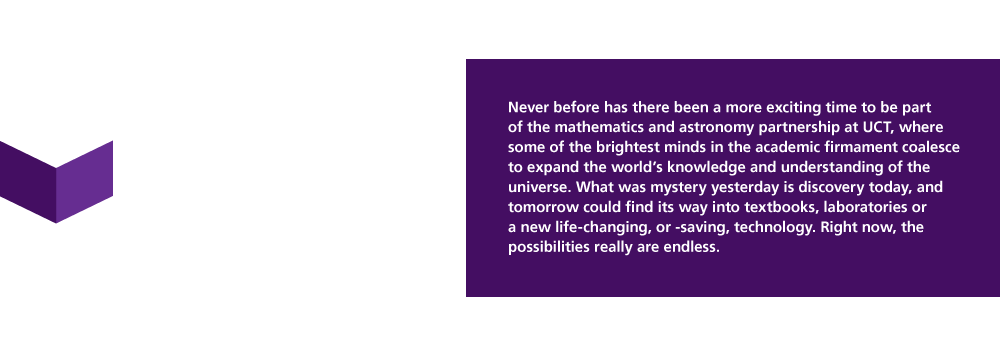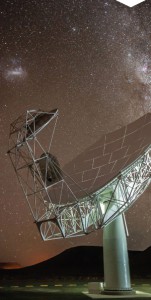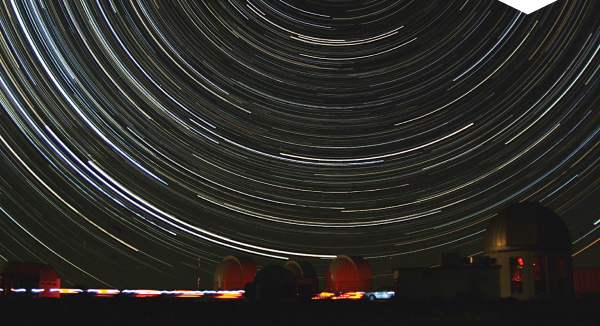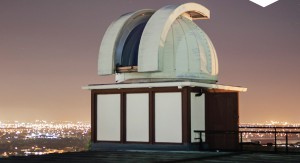Endless possibilities
UCT’s Astrophysics, Cosmology and Gravity Centre (ACGC) is where astronomy and mathematics fuse to produce a string of astounding discoveries and to grapple with the most challenging questions about the universe. In partnership with numerous international research institutions, the ACGC is becoming Africa’s astronomy hub, attracting talented postgraduate students, postdoctoral fellows and faculty from around the world. Additional collaborations with electrical engineering and computer science mean that South Africa is well positioned to make a major contribution to international astronomy research with projects like MeerKAT, the Square Kilometre Array (SKA) and Southern African Large Telescope (SALT).
Perhaps because astronomy encompasses a broad range of technologies and science topics, it is the perfect medium through which to introduce and emphasise the importance of physics and mathematics, and their applications, to a diverse audience.
Sharing the excitements and achievements
Professor Tom Jarrett, DST/NRF SARChI Chair in Astrophysics and Space Science at UCT, says, “Astronomy has a long history of pushing the boundaries of our understanding, as well as technology, and therefore represents the power of investing in research and development. By sharing the excitement of the achievements within this field, we hope to attract young minds and build a foundation within the country that promotes problem-solving, a thirst for knowledge and the belief that anything is possible.”
The importance and urgency of such an understanding cannot be over-emphasised, particularly in the light of the vast international investment in the SKA, which will need local expertise to exploit its full potential.
The SKA will be the world’s largest radio telescope, located in Africa and Australia, but shared by astronomers around the globe. MeerKAT is a precursor to the SKA telescope, and will later be incorporated into the mid-frequency component of SKA Phase 1 when that instrument is being constructed. Until then, MeerKAT will be the most sensitive L-Band radio interferometer in the world. The full MeerKAT array will consist of 64 receptors – antennas with receivers, digitisers and other electronics. Connected by 170 kilometres of underground fibre-optic cable, the 64 receptors will operate as a single, highly sensitive astronomical instrument, controlled and monitored remotely from the MeerKAT control room in Cape Town. By the end of 2014, the first four receptors will have been installed in the Karoo. All 64 will be ready by the end of 2016, with final commissioning completed in 2017.
Dr Amanda Weltman, senior lecturer in the Department of Mathematics and Applied Mathematics, is one of a number of leading researchers who have been drawn to the ACGC because of the importance of these projects. Dr Weltman, who was based at the Centre for Theoretical Cosmology in the Department of Applied Mathematics and Theoretical Physics at the University of Cambridge before returning to UCT, her alma mater, in 2009, says that her timing could not have been better. “From relative obscurity, South Africa is now at the forefront of the international science scene with our winning the SKA bid that will bring the largest scientific experiment of our time to Africa. It is an absolute privilege to be a part of the rapid transformation that South Africa is undergoing as a true science destination,” she says.
The marriage of physicists and astronomers
Dr Weltman joins senior South African astronomers who have held formal meetings to discuss strategy, time frames and optimisation of resources to prepare for the coming SKA era. This includes research in the international arena, recruitment and training of the next generation of astronomers, and advancing human capital development. Professor Jarrett says, “The South African government has invested heavily in science and technology, and hence in its future. It is vital that we physicists and astronomers use our resources and knowledge to excel in several key research areas.”
He explains the close link that exists between mathematics, physics and astronomy: “All scientists need tools, and the way that astronomers decode the ‘language’ of the universe is through mathematics. Physical laws that go into the most sophisticated computer models, algorithms and simulations require mathematics, statistics, and logic and reason to describe them. Here at UCT we have a strong partnership between the astronomers and the mathematical cosmologists, forming a centre of excellence, the ACGC, which is a synergy between empirical research (astronomers at UCT and the South African Astronomical Observatory (SAAO)) and theoretical modelling and analysis (applied mathematics and cosmology).
From relative obscurity, South Africa is now at the forefront of the international science scene with our winning the SKA bid that will bring the largest scientific experiment
of our time to Africa.
The ACGC brings together researchers from the Department of Astronomy and two research groups within the Department of Mathematics and Applied Mathematics, the Cosmology and Gravity Group (CGG) and the QGaSLab (the Laboratory for Quantum Gravity and Strings). Shared areas of research include neutral hydrogen (HI) radio surveys with MeerKAT, galaxy evolution and transformation, large-scale structure, stellar and galactic astronomy, history of astronomy, observational cosmology, dark energy, chameleon dark energy, modified gravity, inhomogeneous cosmology, string theory and string cosmology.
The Department of Astronomy at UCT is active in a variety of additional research themes: extragalactic large-scale structures and evolution of galaxies in the universe, cosmic flow fields, the extragalactic distance scale, detailed studies of the HI (the simplest but most abundant atom in space) and dark-matter content of nearby galaxies, the study of galactic structure, and high-speed stellar photometry and spectroscopy of variable stars and stellar pulsations. With the opening of SALT and the construction of MeerKAT, new research areas have been initiated in galaxy evolution, the relation between dark and visible matter in nearby galaxies, and the evolution of the HI content of the universe.
The CGG has a diverse range of expertise and strong links with the SAAO. Its number of international collaborations has grown, largely as a result of bilateral agreements signed with other countries. CGG is pioneering in both theoretical and experimental aspects of cosmology and physics. Key research themes of the group include, among others, early universe physics, cosmology, non-linear problems in astrophysics and cosmology, modelling inhomogeneity, gravitational wave physics and observational cosmology.
Revolutionary physics and cosmology
One of the CGG’s leading scholars is Emeritus Distinguished Professor of Complex Systems, George Ellis. A veteran cosmologist and National Research Foundation A-rated scientist, Professor Ellis is currently overturning everything we thought we knew about black holes. He has initiated a new attack on the issue of black-hole evaporation, and has released a preliminary report: “Astrophysics Black Holes may Radiate, but they do not Evaporate”. This work is still controversial, but has generated sufficient interest to make it the subject of a news and views article in Nature. It is possible that the final answer will be even more dramatic: black-hole event horizons may never form. This would be a novel statement and would imply that no singularity forms, which would be revolutionary from a theoretical standpoint. However, astrophysical black holes would still exist in that they exert large gravitational forces, as recently tested by researchers in Astronomy at UCT.
Dr Weltman is accustomed to such revolutionary ideas. In this field, new things are being discovered all the time that are turning the world as we know it on its head, she says. She herself is involved in a proposed new solar telescope to be built at the European Organisation for Nuclear Research (CERN) called the IAXO project. Among other things, this telescope will search for so-called chameleon particles from the sun. These particles were co-proposed by Dr Weltman a decade ago in a series of now-famous papers that not only propose this new particle and interaction, but may also explain the observed accelerated expansion of our universe. The IAXO helioscope will search for axions and chameleons and, if either is found, it would be groundbreaking for physics and cosmology.
“What if the universe as we know it – its size, its shape, space and time even – were not fundamental things that exist as an independent stage on which the dance of the stars is set? What if it emerged as a result of the millions and millions of interactions at the very smallest scale, in the same way that none of the macroscopic properties of water – its ability to flow, boil and freeze – manifest at the microscopic molecular level, but are emergent through the interactions of millions and millions of H2O molecules?” asks Dr Jeff Murugan, deputy director of ACGC.
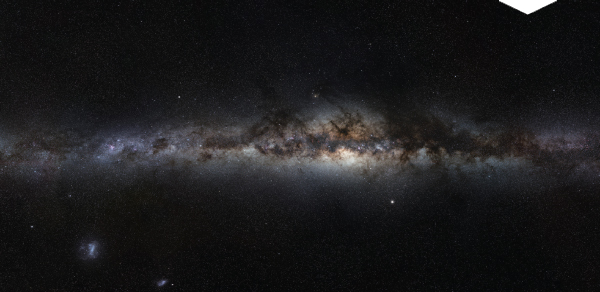
A string theorist, Dr Murugan leads a team of mathematical physicists at UCT and the University of Surrey, who attempted to answer these questions as part of QGaSLaB’s five-year programme on emergent spacetime. So far, they have discovered new quantum objects called giant torii. The novel topology (mathematics-speak for shape) of these objects promises to be a significant step on the road to understanding the nature of space and time at the cutting edge between mathematics and physics.
Using sophisticated tools from an esoteric branch of mathematics called algebraic topology, the team was able to classify these objects according to a set of numbers that were independent of geometry – so-called topological invariants – that they hope to use to develop these ideas further. Dr Murugan was invited to present the findings at String 2014, a major international conference at the Institute for Advanced Study at Princeton University in June 2014.
Another potentially revolutionary area of research is concerned with cosmic voids that occupy more than half the volume of the universe. “Usually the large voids in the universe are expected to cause the images of background galaxies to appear smaller and less bright, owing to the gravitational bending of light known as gravitational lensing,” says Dr Weltman. “Objects on the far side of a void are supposed to be observed as slightly smaller than if the void were not there, which, together with conservation of surface brightness, implies a net reduction in photons received.”
What if the universe as we know it – its size, its shape, space and time even – were not fundamental things that exist as an independent stage on which the dance of the stars is set?
In research over the last year, a team led by cosmologist Dr Chris Clarkson, a senior lecturer in the Astrophysics Cosmology and Gravity Centre, has discovered that, contrary to the usual expectation, objects on the far side of a void are brighter than they would be otherwise. Galaxies behind the void appear brighter and larger than usual owing to the void expanding faster than the surrounding universe, leading to an overestimate of the distance to these objects.
This remarkable result has been labelled anti-lensing and this important change to the standard picture of cosmic magnification is now being taken into account in the UK component of the international Sloan Digital Sky Survey (SDSS) collaboration. The SDSS is a major multi-filter imaging and spectroscopic redshift survey using a dedicated 2.5-metre wide-angle optical telescope at Apache Point Observatory in New Mexico, United States. A first detection is expected by the end of 2014. Further afield, it is being taken into account in Euclid and SKA predictions.
Galaxies in a supermassive tango
In yet another groundbreaking discovery, a team of international astronomers, led by Professor Jarrett, has uncovered a rare astrophysical phenomenon that may produce powerful ripples through space. A pair of supermassive black holes, each over a billion suns in cumulative mass, are swirling at the centre of the galaxy known as WISE J233237.05-505643.5. When two large galaxies collide and merge into one system, their central black holes are expected to coalesce in a spiralling dance of death.
Although galaxy mergers are relatively common, catching them in the act has eluded astronomers, with only a handful of such systems currently known, and none as large as the system found by the team of astronomers from UCT, the National Aeronautics and Space Administration (NASA) and the Commonwealth Scientific and Industrial Research Organisation (CSIRO), Australia’s national science agency. These energetic events are important to study because, when the nuclei merge, effectively swallowing each other and creating a larger central black hole, they release powerful gravitational waves, sending ripples through space that can be detected on Earth. Gravitational waves, predicted by general relativity, are the last cornerstone of discovery for the famed theory of gravity first postulated by Albert Einstein. This important discovery and details of the team’s work were published in the December 2013 issue (volume 779) of the Astrophysical Journal.
KAT-7 yields first scientific paper
Other key publications from the last year include the first scientific paper based on observations performed with South Africa’s new KAT-7 radio telescope. Authored by alumnus Dr Richard Armstrong, a SKA SA Fellow at UCT, with co-authors Professor Rob Fender, SKA visiting professor at UCT and head of the Astronomy Group at the University of Southampton (UK), and Associate Professor Patrick Woudt, deputy head of the Department of Astronomy, and titled “A Return to Strong Radio Flaring by Circinus X-1 Observed with the Karoo Array Telescope Test Array KAT-7”, the paper was accepted by the journal Monthly Notices of the Royal Astronomy Society.
UCT researchers are leading four of the approved MeerKAT Key Science Projects, representing a quarter of MeerKAT time. One of these projects is the 3 000-hour ThunderKAT survey for astrophysical transients. Dr Armstrong has been working on the design of this survey together with Professor Fender and Associate Professor Woudt, the leaders of the ThunderKAT project that will search for all types of radio bursts and flashes in KAT-7 and MeerKAT data on timescales from seconds to years. The specialised MeerKAT Karoo Array Processor Building is the cutting-edge data centre for the MeerKAT telescope that has been built in an underground bunker at the Karoo observatory site. KAT-7 was completed in 2010 as an engineering prototype for MeerKAT.
In another world first, a team of UCT PhD students and postdoctoral fellows led by Professor Claude Carignan, DST/NRF SARCHI Chair in Multi-wavelength Astronomy, together with SKA SA scientists Dr Sharmila Goedhart and Dr Sean Passmoor, has published, in the prestigious Astronomical Journal, the first scientific publication on HI using KAT-7 observations. The astronomers pointed the telescope towards a galaxy called NGC 3109 – a spiral galaxy about 4.3-million light years away from Earth, located in the constellation of Hydra. Their aim is to study its dark-matter content and they have already accumulated more than 120 hours of observations.
Five among trillions

Emeritus Honorary Professor Michael Feast.
It is hardly surprising that the researchers behind these new discoveries are earning international reputations for excellence in their own right. Emeritus Honorary Professor Michael Feast of the Department of Astronomy is one of a handful of South African astronomers whose work has earned him an NRF A-rating. At the age of 87, he has published a paper on Cepheid stars (one of the tools used in studies of the cosmic distance scale) in Nature, 66 years since his first offering appeared in this prestigious, multidisciplinary journal, when he was a fresh-faced 21-year-old.
Co-authored with colleagues Professor Patricia Whitelock and Dr John Menzies from the SAAO, and in collaboration with Japanese researcher Noriyuki Matsunaga (University of Tokyo), the paper is the result of the study of just five pulsating Cepheid stars.
“The Milky Way,” explains Professor Feast, “appears as a bright band across the night sky and is part of a great disc of stars and other matter that is the most prominent component of our galaxy. Our sun is in this disc, about 28 000 light years from the centre. The region within 10 000 light years of the sun has been well studied and shows that stars are kept in the disc by the combined gravitational attraction of all the stars there.”
now we are so much closer to the physics, or particles, the universe is made of, although there are still many questions to be answered.
The paper relates to what happens as one goes to the outer regions of our galaxy. Radio astronomers have used observations of hydrogen gas to show that a disc still exists there, though thicker than near the sun. Astronomers describe this as “flared”.
“However, the density of stars is not sufficient to hold the gas in place,” says Professor Feast, “suggesting that dark matter of an unknown type may provide some of the gravitational force. The behaviour of the gas is difficult to study, as its distance cannot be determined in any direct way and our understanding of the outer galaxy depends on a theoretical model.”
Professor Feast and his co-authors have been studying the five stars (Cepheid variables) whose distances they can determine directly, and which they show to be in this flared outer disc – the first stars to be discovered there. “These are special stars,” he says. “They are 75 000 light years from the sun and up to a million times fainter than the faintest stars visible to the naked eye. To study them we needed observations from the Japanese–South African Infrared Survey Facility, as well as crucial observations from SALT. The few stars we have located must be just the tip of the iceberg and future work involving, for instance, ground-based follow-up of observations, made by the recently launched astronomical satellite Gaia, will present opportunities to probe in detail the distribution of dark matter in the outer galaxy and give clues to its nature.”
The excitement of discovery never dims for Professor Feast: “When I came into astronomy we were just getting used to the idea that the universe was expanding. Now we are so much closer to the physics, or particles, the universe is made of, although there are still many questions to be answered.”
An international knowledge exchange
International collaboration, such as that with the University of Tokyo, is standard for this area of research. As UCT grows as a hub for astronomy and astrophysics research in Africa, it is also increasingly channelling resources and outreach to neighbouring countries. The university is a partner in research projects involving eight other African countries in this field, and has led research outreach to Mozambique and Ethiopia in recent years. Its goal is to train future leaders in radio astronomy and mathematics of the universe across the continent.
As part of this, the Department of Astronomy hosted a large international conference on galactic and extragalactic novae early in 2013. This important meeting of the most exciting minds in the field was called “Stella Novae: Past and future decades”. It was only the fourth in a prestigious series of international conferences ever held on classical novae, following “Novae and Related Stars” in Paris in 1976, “Physics of Classical Novae” in Madrid in 1989, and “Classical Nova Explosions” in Sitges in 2002.
The occasion brought together 90 experts and young emerging researchers from around the world to discuss their latest research in understanding the evolution scenarios of the binary systems in classical novae, the physics of the nova explosion, the energetic feedback of the nova ejecta into the interstellar medium, and multi-wavelength observations and modelling of the nova outburst, as well as the relationship between novae and type Ia supernovae, which occur in binary systems where two stars are orbiting one another.
Since the last conference in 2002, new developments in nova research have emerged, and it was in Cape Town that the latest developments were explored in the nova field, from both theoretical and observational points of view, throughout the whole of the electromagnetic spectrum. Another topic of animated discussion was the possible future potential for discovery with the advent of all-sky surveys of the transient sky, global networks of robotic telescopes and large future telescope facilities that provide scientists with new windows into the study of classical and recurrent novae.
Building a local talent base
Events such as “Stella Novae: Past and future decades” play a major role in building local expertise in Africa – and, by extension, at UCT. According to Professor Renée Kraan-Korteweg, the head of the Department of Astronomy, there is a shortage of good astronomers in South Africa, in particular radio astronomers, and this is a major threat to the future of SALT, SKA, MeerKAT and astronomy in general. “UCT’s goal is to train future leaders for these kinds of opportunities,” she says.
There is a need to take astronomy to
students of all walks of life.
UCT is currently the only South African university to include a major in astrophysics in its undergraduate programme. It is attracting a steadily increasing number of students. Professor Kraan-Korteweg noted that 75% of undergraduates in the astrophysics programme in 2012 at UCT were black South Africans. UCT also offers a range of postgraduate study opportunities in the field, primarily through the National Astrophysics and Space Science Programme (NASSP). NASSP began as a result of a National Research Foundation strategy-planning exercise in 2000 and has, in the past decade, tried to address the lack of local astronomers, and black astronomers in particular, by offering postgraduate degree programmes and research support to promising students. The overarching aim is to produce an international network of African astronomers, space scientists and citizens bonded by the common experience of schooling and interlinked both professionally and personally.
In addition to an eventful research year in 2013, the NASSP has drawn recruits from third-year mathematics, physics and engineering undergraduates, allowing South African students and those from around Africa and the rest of the world to study under the guidance of some of South Africa’s leading scientists. Those students who graduated from the programme in 2013 are now equipped to do research at the cutting edge of astrophysics and have the broad science skills needed in a modern technological society.
Bringing astronomy down to earth
Important as these initiatives are, Professor Jarrett says that the astronomy hub at UCT also has ambitions to make astronomy more accessible to more people, and the launch of the Tony Fairall Teaching Observatory in December 2013 will go a long way towards achieving this aim.
Named after the late Professor Tony Fairall, a much-loved and longstanding member of the Department of Astronomy at UCT, who himself spent much of his career trying to make astronomy more accessible to the general public (he was the director of the Cape Town Planetarium for 17 years), the teaching observatory was unveiled in December 2013, and houses a new Celestron 14-inch telescope. Equipped with a modern CCD (telescopic camera) and spectrograph, the telescope will be used for teaching purposes as part of the undergraduate astrophysics curriculum. “Astronomy is more than PhD and MSc degrees,” says Professor Jarrett. “There is a need to bring astronomy to students of all walks of life. With the newly launched Tony Fairall Teaching Observatory, astronomy can be used to train and entertain, and this is something we hope to make accessible to high-school students and the public at some point in the future.”
This is just one more way in which UCT is positioning itself as a centre of excellence in mathematics and astronomy. Projects like the Teaching Observatory developing alongside MeerKAT, the SKA and the slightly older SALT are allowing UCT’s brightest minds in mathematics and astronomy to collaborate in ways that were unthinkable a decade ago. Exactly what this collaboration will yield in the years to come is for now as much a mystery as the more challenging questions around the mathematics of the universe but will, no doubt, prove every bit as exciting and astounding.


